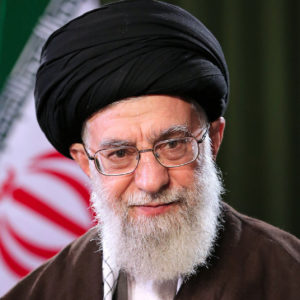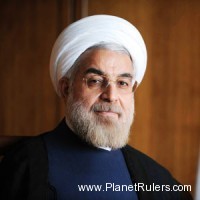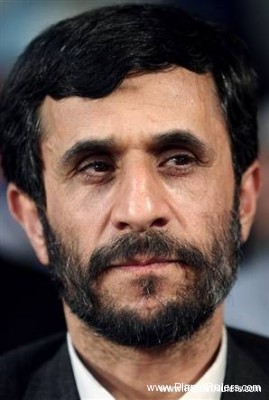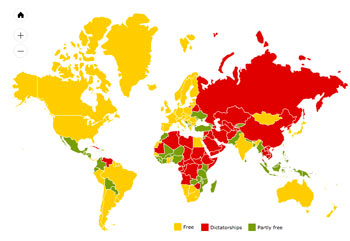Ali Khamenei, 2nd Supreme Leader of Iran (since 4 June 1989)
 Sayyid Ali Hosseini Khamenei – born 19 April 1939 – is a Twelver Shia Marja’ and the second and current supreme leader of Iran, in office since 1989. He was previously the president of Iran from 1981 to 1989. Khamenei is the longest serving head of state in the Middle East, as well as the second-longest serving Iranian leader of the last century, after Shah Mohammed Reza Pahlavi.
Sayyid Ali Hosseini Khamenei – born 19 April 1939 – is a Twelver Shia Marja’ and the second and current supreme leader of Iran, in office since 1989. He was previously the president of Iran from 1981 to 1989. Khamenei is the longest serving head of state in the Middle East, as well as the second-longest serving Iranian leader of the last century, after Shah Mohammed Reza Pahlavi.
According to his official website, Khamenei was arrested six times before being sent into exile for three years during Mohammad Reza Pahlavi’s reign. He was the target of an attempted assassination in June 1981 that paralysed his right arm.
Khamenei was one of Iran’s leaders during the Iran–Iraq War in the 1980s, and developed close ties with the now powerful Revolutionary Guards which he controls, and whose commanders are elected and dismissed by him. The Revolutionary Guards have been used to suppress opposition to him. Khamenei served as the third president of Iran from 1981 to 1989, while becoming a close ally of the first supreme leader, Ruhollah Khomeini. Eventually, after Khomeini had a disagreement with the then heir apparent Hussein Ali Montazeri, Akbar Hashemi Rafsanjani claimed that Khomeini had chosen Khamenei as his successor while the Assembly of Experts deliberated to elect the next Supreme Leader. After Khomeini’s death, Khamenei was elected by the Assembly of Experts as the new Supreme Leader on 4 June 1989, at the age of 49. He has been head of the servants of Astan Quds Razavi since 14 April 1979.
As Supreme Leader, Khamenei is the head of state of Iran and the commander-in-chief of its armed forces. For this reason, he is considered the most powerful political authority in the country. As Supreme Leader, Khamenei can issue decrees and make the final decisions on the main policies of the government in many fields such as economy, the environment, foreign policy, and national planning in Iran. According to Karim Sadjadpour, Khamenei has either direct or indirect control over the executive, legislative and judicial branches of government, as well as the military and media. All candidates for the Assembly of Experts, the Presidency and the Majlis (Parliament) are vetted by the Guardian Council, whose members are selected directly or indirectly by the Supreme Leader of Iran. There have been also instances when the Guardian Council reversed its ban on particular people after being ordered to do so by Khamenei.
There have been major protests during Khamenei’s reign, including the 1994 Qazvin Protests, the 1999 Iranian student protests, the 2009 Iranian presidential election protests, the 2011–12 Iranian protests, the 2017–18 Iranian protests, and 2018–2019 Iranian general strikes and protests. Journalists, bloggers, and other individuals have been put on trial in Iran for the charge of insulting Supreme Leader Khamenei, often in conjunction with blasphemy charges. Their sentences have included lashing and jail time, and some of them have died in custody.[38][39] Regarding the nuclear program of Iran, Khamenei issued a fatwa in 2003 forbidding the production, stockpiling, and use of all kinds of weapons of mass destruction.
Source: https://en.wikipedia.org/wiki/Ali_Khamenei
Hassan Rouhani, President of Iran (re-elected on May 19, 2017)
 May 19, 2017 – in presidential elections, Hassan Rouhani wins 58.8% of the vote; Ebrahim Raisi gets 39.4%. Turnout is about 73%.
May 19, 2017 – in presidential elections, Hassan Rouhani wins 58.8% of the vote; Ebrahim Raisi gets 39.4%. Turnout is about 73%.
Hassan Rouhani (born 12 November 1948) is the 7th President of Iran, in office since 2013. He is also a Muslim cleric (with the status of a Shia Mujtahid), lawyer, academic and former diplomat. He has been a member of Iran’s Assembly of Experts since 1999, member of the Expediency Council since 1991, member of the Supreme National Security Council since 1989, and head of the Center for Strategic Research since 1992.
Rouhani was deputy speaker of the 4th and 5th terms of the Parliament of Iran (Majlis) and Secretary of the Supreme National Security Council from 1989 to 2005. In the latter capacity, he also headed Iran’s former nuclear negotiating team and was the country’s top negotiator with the EU three – UK, France, and Germany – on Iran’s nuclear program.
On 7 May 2013, Rouhani registered for the presidential election that was held on 14 June 2013. He said that, if elected, he would prepare a “civil rights charter”, restore the economy and improve rocky relations with Western nations. Rouhani is viewed as politically moderate. As early vote counts began coming in, he took a large lead. He was elected as President of Iran on 15 June, defeating Tehran mayor Mohammad Bagher Ghalibaf and four other candidates. He took office on 3 August 2013. In 2013, TIME magazine named him 9th Most Influential People in the World. In domestic policy, he encourages personal freedom and free access to information has improved women’s rights by appointing female foreign ministry spokespersons, and has been described as a “”reformist” who has improved Iran’s diplomatic relations with other countries through exchanging conciliatory letters.
Source: http://en.wikipedia.org/wiki/Hassan_Rouhani
Mahmoud Ahmadinejad, Former President of Iran
Dr. Mahmoud Ahmadi Nejad was born in 1956 in the village of Aradan in the city of Garmsar. He moved and stayed in Tehran together with his family while he was still one-year old and completed his primary as well as his low and high secondary education there. In 1975, he successfully passed the university entrance exam with high marks and started his academic studies on the subject of civil engineering in the Science and Technology University in Tehran.
In 1986, he continued his studies at MS level in the same university. In 1989, he became a member of the Board of Civil Engineering Faculty of the Science and Technology University. In 1997, he managed to obtain his Ph.D. on transportation engineering and planning from the Science and Technology University.
Dr. Ahmadi Nejad is familiar with English language. During the years when he was teaching in the university, he wrote many scientific papers and engaged in scientific research in various fields. During the same period, he also supervised the theses of tens of students at MS and Ph.D. levels on different subjects of civil engineering, road and transportation as well as construction management.
While still a student, Dr. Ahmadi Nejad engaged in political activities by attending religious and political meetings before the Islamic Revolution. With the victory of the Islamic Revolution, he became a founder and also a member of the Islamic Association of Students in the Science and Technology University. During the war imposed on Iran, Dr. Ahmadi Nejad was actively present as a member of the volunteer forces (Basij) in different parts and divisions of the battlefronts particularly in the war engineering division until the end of the war.
Dr. Ahmadi Nejad is married and has three children- two sons and one daughter.
Career Background:
– Governor of Maku
– Governor of Khoy
– Advisor to the Governor General of Kordistan Province
– Advisor for cultural affairs to the Minister of Culture and Higher Education (1993)
– Governor General of Ardabil Province (1993-1997)
– Member of the Board of Civil Engineering Faculty of the Science and Technology University (since 1989 till present date)
– Tehran Mayor (2003-2005)
– He was elected by the Iranian people as the President during the 9th presidential election on June 24, 2005.
In addition to his academic and scientific pursuits as well as his executive positions, Dr. Ahmadi Nejad has engaged in the following careers and activities as well:
– Journalism; writing various political, social, cultural and economic articles,
– In the same career, he also held the position of managing director of Hamshahri newspaper and launched various affiliated periodicals including Neighborhood Hamshahri published and distributed in 22 areas of the city of Tehran, Hamshahri for Passengers, Diplomatic Hamshahri, Youth Hamshahri, Monthly Hamshahri and also extra pages attached to the Hamshahri newspaper for thinkers, students, etc.
– Founding and working as a member of Iran Tunnel Society,
– Working as a member of Iran Civil Engineering Society,
– Working as a member of the first central council of the Islamic Association of Students in the Science and Technology University,
– Working as a member of the first central council of the Union of Islamic Associations of University and Higher Education Institutes in Iran.


